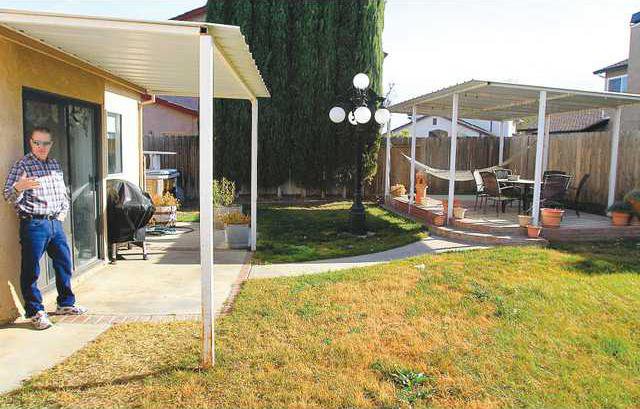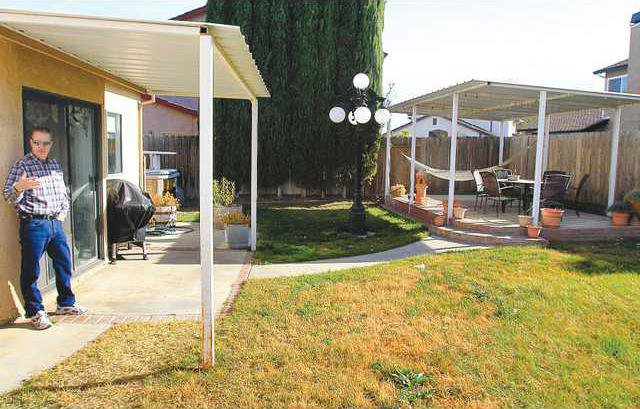The clock is running for Doug Zirpel.
If he doesn’t comply soon to a directive from the City of Manteca to tear down a non-conforming shade structure that hugs the property line, the Manteca homeowner will face fines of $500 a day and possibly six months in jail.
Two of his neighbors on Pete Court in west Manteca who received similar demands from the city have torn down their non-complying shade structures attached to the side of their homes after deciding that the economic times make it too risky to take on city hall. All three were told they had structures – sheds, patios, or shade coverings – too close to the property line and therefore were creating fire hazards and violating city law.
Zirpel, though, isn’t budging. In fact, he’s fighting back. He’s challenging Manteca’s elected leaders to stop selective enforcement or make everyone comply. To prove his point, he went on a quick 20-minute drive in the neighborhoods surrounding Sierra High and pointed out 33 other non-complying patio and sheds visible from the street that are clearly within five feet of the fence line.
Several of the “offending” structures that escaped detection by the city are not just clearly visible from the street but are also actual structures – complete with stucco walls and roofs – that homeowners of a new subdivision built in the early 2000s put right up against the fence lines with lights installed for apparent use as outside sheds.
Zirpel and his two neighbors were turned in to code enforcement sometime in November by a city building inspector called out to check a roof on a foreclosure that was being prepared for sale. From his vantage point in the street the city employee noted the code violations of the three homes – all within two doors of the house being inspected - but not other violations clearly visible going to and from the court.
Zirpel noted that every home on the street – the neighborhood was built in 1989 – has been re-roofed and apparently inspected by city inspectors during the past 10 years or so. Yet no inspector before questioned any of the shade structures tagged as non-conforming previously despite them being in place almost as long as the homes have been standing.
“It almost seems they’re doing it now because they’re worried that the city needs to generate money so they can keep their jobs,” Zirpel said.
One neighbor – Pat Mullin – tore down a shade structure attached to the side of his garage to avoid being fined. He was told the structure made of steel was a fire hazard. He has also been told to remove a patio structure within five feet of the side and rear fence lines and that a yard light on a post is out of compliance because he did not obtain a city permit. It is not clear whether a patio shade structure over his back slider is in compliance or not.
Other violators seen from yard not cited
“This is well anchored,” Mullin said as he shoved a supporting post of the patio that includes a hammock that has been used for years attached to the steel posts. While the patio structure is almost on top of the fence line, it is set back a good 20 plus feet from the nearest house in the rear. The house to the side is closer but peering over the fence it appears there is a light installed improperly that escaped the city’s attention simply because the code enforcement officers could not see it from the street. Standing on the patio structure you can see into backyards that clearly have structures too close to the fence line but were not cited.
Zirpel was told he had three structures in violation: The shade cover on the side of his garage where he parks his car and has had everything from graduation and birthday parties to gatherings after family funerals; a metal shed, and a patio structure. All three were within five feet of the property line.
Zirpel moved the shed five feet away and now half of it hangs over the grass while the other half remains on a cement slab. He disconnected a light fixture that he had wired without a permit to an electrical outlet box under the shade structure.
As for the actual shade structure by the side of the garage, a contractor has told him it would take $2,000 to bring it up to standards the city is requiring but he would have to lop off five feet rendering it essentially useless to park a vehicle under.
Standing on a brick BBQ area on his rear patio, you can see a number of structures that neighbors have put up to the fence line but they were not cited because the inspector could not see them from the street.
In the neighborhood drive by, there were a number of structures just like Zirple’s shade structure clearly visible from the street that clearly were not part of the original home construction and either crowd or go right up to the fence line.
Code enforcement is political hot potato
Zirpel thinks it is ironic that the city approves zoning and code standards as well as CC&Rs – covenants, conditions and restrictions – when they approve developments but they opt to never enforce CC&R violations. Instead they say it should be treated as a civil matter if a homeowner on a parcel created with a city approved CC&R attached puts in place a TV antenna, paints the house an unauthorized color, or a multitude of other things that were required by the city as a condition of approval of the subdivision map.
Code enforcement has historically been a political hot potato in Manteca.
In the 1990s after it became apparent to council members that neighbors were targeting other neighbors in disputes, the council told staff that when they act on a reported code violation that they must enforce similar violations the code enforcement officer can see within a reasonable distance of the complaint. What triggered that policy was one gas station owned by an Iraqi Christian immigrant who always was being turned into the city for sign violations despite 20 other violations being visible within two blocks in either direction from Yosemite Avenue business.
The council – after getting complaints about Toters being left out in view – ordered city rules regarding their placement to be enforced. It was done first on a case by case basis – essentially complaint driven – and then it was expanded to those within a block of the address the complaint was made about.
When that also brought protests, the council directed staff with the assistance of Seniors Helping Area Residents and Police – to issue warnings citywide and to continue doing so and even issue citations if needed to get compliance. That strategy worked.
Now the city is working on a new sign ordinance to bring non-conforming A-frame signs into compliance.
The setback rule is a bit different as it addresses fire access and fire safety.
Even so, Zirpel noted the city is being completely arbitrary in how they enforce it.
Backing up his point is the city agency that actually is concerned the most about fire safety – the fire department – that conducts annual inspections of all property in the city checking for weeds and debris clearly visible from a fire engine on the street. All of the 33 other structures that Zirpel pointed out during his short drive – plus hundreds if not thousands of more throughout Manteca that are too close to property lines – would also be visible from a fire engine.
Will city come after you next?
Manteca orders patios, sheds torn down or moved



